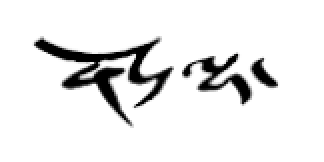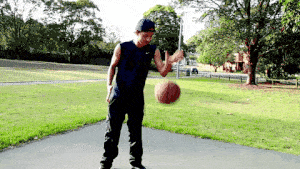Contents > 3. Offense > 3.1. 1/4-Court vs. Player-to-Player Defense > 3.1.1. 1v1 > 3.1.1.2. During the Dribble > 3.1.1.2.1. Basic Stationary Dribbling >
3.1.1.2.1.1. Basic Stationary Dribbling: Alone
(1) Q: What is an effective way to perform a basic dribble with one hand, while alone, and not moving in any direction?
A: We will first discuss the primary body parts used, then discuss the motion.
Q: What body parts are involved in an effective basic dribble?
A: Below are the body parts to pay attention to that will help allow for more control and power when dribbling:
Use your fingers (not your palm), spreading them wide on the ball
Keep your hand on top of the ball (there will be times in the future when the hand will be on the side of the ball, but never under the ball since that is a violation)
Allow your wrist to remain flexible
Allow your elbow to both bend and extend fully
Keep your hand on the ball as long as possible (when the ball is not in your hand, you cannot control it)
Keep your eye on the ball (for now this is appropriate to keep track of the ball; later on we will stop looking at the ball)
Be able to use both hands/arms separately
For your legs, ideally perform the dribble in an athletic/triple-threat stance (for a stronger base, and to be able to dribble drive or shoot when necessary); however for now if you wish, you may focus only on the upper body, standing up straight
(notice the body parts used in this effective dribble - note you may focus on the upper body for now, as this player is standing up straight, and is looking at the ball while dribbling)
(note this player then transitioned into an athletic stance, and also is no longer looking at the ball)
Q: What is an effective motion for basic dribbling?
A: Below are the general steps that will help with an effective basic dribbling motion:
Start from the triple threat position. Your dribbling arm’s wrist and elbows will be bent (“loaded”) in this position.
Push the ball straight down with your dribbling hand, keeping your hand on top of the ball
Continue pushing down until your elbow is extended fully (allowing for more power, and allowing the ball to stay in your hands as long as possible, as close to the ground as possible)
Release the ball to the ground by flicking it off your fingers with your wrist
Let the ball bounce off the ground
On its return upwards, receive the ball from the ground with your hand as low as possible to the ground (elbow fully extended)
Guide the ball back to the starting position with the same hand, bending your wrists and elbows back into their starting/”loaded” position
Continue to repeat this motion
(Notice each step of the motion of this effective basic dribble)
(Notice the use of the palms and rigid wrists in this ineffective dribble, having less control)
(Notice the ball is kept in the hand as long as possible in this effective basic dribble, elbows fully extended)
(Notice the ball is not in the hand for as long as possible in this ineffective basic dribble; the hand releases and receives the ball very high, and the elbow does not extend fully)
Q: How do I know where the ball will go after bouncing it?
A: After pushing down and the ball hits the ground, the ball will return with equal and opposite force (the same speed in the exact opposite direction). Dribbling straight down will cause the ball to bounce straight back up. Use this knowledge to know where the ball will end up after bouncing (eventually you will be able to stop watching the ball, since your body and mind will know where the ball will be).
Q: What factors will affect the speed and height of the ball bounce?
A: There are two main factors that will usually affect this:
Force: how strong you dribble the ball. The harder the dribble, the harder/faster it will come back and the higher it has potential of reaching on the return
Starting height of the dribble: these heights can generally be broken down into low (start dribbling below the knees), medium (between the knees and the waist), and high (above the waist)
Skills Drills
NOTE: During dribbling drills, it will be very common for “mistakes” to occur (for example, losing control of the ball); this is okay!
Skills Drill #1: Basic Dribble
Each player has a ball. Get into triple threat stance (or if needed, stand straight up to begin with). Dribble through each phase below, 10-20 seconds at a time with each hand (right hand, left hand)
Normal - dribble with eyes watching the ball
Eyes closed - dribble with your eyes closed
Partner numbers - dribble with eyes open and a partner/coach in front of you holding up different numbers with their hand; the dribbler must yell out the corresponding numbers. If a partner isn’t present, the dribbler should keep their eyes forward without looking at the ball.
Skills Drill #2: Pound Dribbles, Varying Heights
Same as skills drill #1, however the dribbler will now perform pound dribbles (dribbling as hard as they can), from three different heights (low, medium, and high).








